Episode #420: How to Build a Math Plan That Survives Leadership Changes
LISTEN NOW HERE…
WATCH NOW…
What happens to your math improvement efforts when you leave the role?
Many school and district leaders assume that lack of time or teacher buy-in is the biggest barrier to sustainable change. But the real threat? Fragility—the risk that everything falls apart when key people leave or switch roles. In this episode, we unpack the often-overlooked issue of leadership transition and how it stalls momentum, erodes trust, and resets years of progress. You’ll hear real-world case studies and actionable strategies for building an infrastructure that outlasts any single leader.
You’ll learn:
- How to avoid the “spaghetti at the wall” cycle every time leadership changes
- What distributed leadership really looks like in successful math programs
- How to create structures that sustain the work—no matter who’s at the helm
Press play to discover how to future-proof your math leadership and build lasting momentum across your district.
Attention District Math Leaders:
Not sure what matters most when designing math improvement plans? Take this assessment and get a free customized report: https://makemathmoments.com/grow/
Ready to design your math improvement plan with guidance, support and using structure? Learn how to follow our 4 stage process. https://growyourmathprogram.com
Looking to supplement your curriculum with problem based lessons and units? Make Math Moments Problem Based Lessons & Units
Be Our Next Podcast Guest!
Join as an Interview Guest or on a Mentoring Moment Call
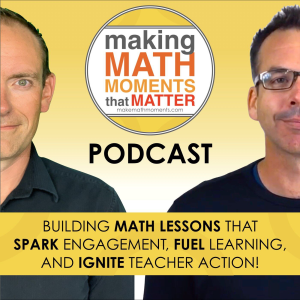
Apply to be a Featured Interview Guest
Book a Mentoring Moment Coaching Call
Are You an Official Math Moment Maker?
FULL TRANSCRIPT
We’re going to continue our discussion on fragility and addressing sometimes what we often think of as our major barrier to math improvement across a system, a school, but also long lasting as we have traction, know, sustainability. Like sometimes we often think that time is one of our biggest barriers or if we think, you know, buy-in is our biggest barrier with teachers, but our biggest barrier, and this is, remember, a continuation from the previous episode where we unpacked that barrier, but also we gave one tip on how to address that barrier for a long lasting plan, which we were talking about codification and that. And this one we’re gonna kind of extend that to think about some other ideas and practical ideas to address this fragility barrier, which is really, really restating that it’s not time, it’s not buy-in with teachers, really that’s preventing us. It’s what happens if the person leading the work leaves or switches roles. And what we’re seeing and what you know from your own school or school district is that if you if you’re that person, if the math program lives with you right now, and you retire or you go back to the classroom or you step into say, to a new a new department, you know that it’s going to be halted or all of sudden things are going to come to a screeching halt and all the work that you’ve been working on is like the person coming in all of sudden has to like start from scratch. And that right there is one of the hugest barriers we’re all up against for long lasting sustainable improvement because that person now has to go like, well, I don’t, what were we doing? And then now I have to catch up to the learning there even just to continue and we have halting. And what really happens is like they just throw everything out and go like, well, what should we do now? Like here’s my plan. And then this is where teachers start to see this is a different thing added to my plate. Whatever we did last year doesn’t matter. It’s like we just keep switching focuses and we’re doing the spaghetti at the wall approach. It just perpetuates that myth that that’s what improvement is at schools and us district office people are not trusting when it comes to classroom teachers. So we wanna talk about that here today. We’re gonna be kind of unpacking some case studies, some practical examples that we’ve been sharing with our teams, but also from our teams and the work that they’ve been doing. Yvette, let’s dig in. Where do you want to start first?
I was actually thinking as you were describing or introducing this idea that I also want to say that, sometimes change is good. Like sometimes having the same person in the same role for 10 years, it’s like, you know, it becomes stagnant or we should be getting diverse perspectives. And I think that sometimes with change comes opportunity. But what we don’t want is for those changes to continuously happen and then they disrupt the system. And so it’s like, what do we have to put in place systemically so that even though a new perspective or a new voice can invigorate or inspire, it doesn’t halt or disrupt or upend the work we’ve been doing for the past few years. And I can think about two things, and I’m sure, know, on Monday we touched on these and we’ll go a little bit deeper, but top of mind for me is that idea of distributed leadership or shared ownership of this work that, you know, our job as a leader is to build other leaders. And so we have actually a district we talked about recently who’s doing a really great job at this right now. It’s a single coordinator who oversees, let’s say math for grades six through 12. And they’ve recognized, right? Like I can’t be the one leading this work. I need my instructional mentors on the team. I need my department chairs on the team. And these are people who could potentially step into the role if I walk away. And we all have a same vision for what we wanna see happening five years from now. And the other piece is like those systems. So it’s like, how do we leverage PLCs? What does professional learning look like? And if we create a culture or a system of ways that we’re leveraging our subsystems that is teachers own, and it’s like teachers are living and breathing these structures because they’re just part of our common practice in the way that we do business, it’s really hard to disrupt them. So I think those are two ways that we have to talk about sustainability is that idea of shared ownership and distributed decision-making and leadership, but then also structures that even if the plan adjusts, they’re gonna hold.
Yeah, yeah, and I’ll start with the structures and the plans, because we talked about that on the Monday episode of like, how do we codify the work we’re doing? How do we make it part of what we do here? And how do we systematize professional development? How do we systematize the learning that we can carry forward so it’s not just isolated or it’s not just like these blips that all of sudden are there and then they’re gone and we don’t, how do we capture them and how do we make it part of our system? You know, I think it’s very meta, you know, is, I think when we think about professional development, we think about, you know, holding professional development sessions, running a workshop, you know, leading a PLC. And what I mean by the meta part is like thinking about like, are we taking time to unpack the what, like what the structure actually is and why we’re doing it the way we’re doing it with the people we’re leading? Because, because that’s the part I think that can build the culture and the fabric of how we can sustain the work that you’re trying to do. So for example, like you’re making conscious decisions about how to link your PD sessions, your full out PD sessions at the beginning of year, the middle of the year with your PLCs that you’re maybe helping support it in their schools. And maybe you’re helping principals set appropriate school level goals. And all three of those things are seems separate, but you’re making a conscious choice there to support those three pieces. But are you bringing those teachers, those administrators into the fold of like, this is our plan and here’s why we’re doing what we’re doing. We’re doing this because of this reason, it supports this goal. But the structure itself, let’s talk about the benefits of the structure itself and teach your teams, teach your people that the reasons do you make these decisions because we have to pass that on. Like that’s how we have to say, like this is how we do PD there. We start with our goal. We start looking at our subsystems. We think about like, how do we align these subsystems? We have to teach others the learning that we have about that, which is like passing that system on and documenting that system is like, that’s the system part that I think we all forget about or we don’t think about. We just think about giving PD or holding sessions to teachers because that’s what we’re after. But I mean, if you’re not building leaders, you’re not gonna pass this on. It’s just gonna halt. And I think that’s the part that we have to think about, internalize, is to say, are we answering that question as well?
So what I heard you say is we need to bring people, and you’ve said this before, like to the inside, like help them see why decisions were made, not just the result of those decisions. Like don’t allow it just for them to experience it as like a recipient of this system or these, you this learning, but actually let them in on the inside. Like let them know why we’re doing what we’re doing and thinking behind it, that we can understand why this system is going to serve us long-term. It doesn’t seem totally random or, know, there’s a lot of intention. I think the other part that we talked about is, and like I’ve heard this before, right? It’s like, you’re always bringing people up behind you. So like, if you step into a coaching role, you’re working with teachers and you’re looking for like, who are the next coaches? Like, who are the people that could step into my role if I was to go? you know, off on a leave tomorrow or I was to transition to another board. If I’m a curriculum coordinator, I’m like, okay, well, you know, who are the coaches or who are the instructional mentors or who are the bright spot teachers that I could bring into the conversation that I could be building their capacity, knowing that at some point there’s going to be a transition. And we’ve seen some of our districts do this really well. We have a few really shining examples. One actually that just transitioned this year, the person who was leading the team of coaches went on to a role at the province level, at the ministry, but we don’t anticipate any disruption to the work because everybody else on the team was on the inside. There weren’t decisions being made behind closed doors. People were in, although it can be messy at times and it can maybe take a little bit longer to land on a decision, it’s like people were privy to the information. They were part of the decision making process. They deeply internalized the vision and the work and the objectives and the plan for this year. And so that work is going to continue because there is already distributed leadership amongst the team. And knowing that at some point this transition may happen, knowing that there were people that could easily step into the role.
Yeah, like they’re shining, like you said, example of, and you said distributive leadership, is research from James Spillane that we’ve brought into our system and helped share how we can be applying that research into math, specifically math improvement. And that idea of distributive leadership is about bringing people into the inside. There’s another book that we’ve referenced here on the podcast, Which was called all in by Mike McCalliwitz, which was about like, how do I bring people and treat? Now, how do people how do I get more people to treat the work like they own it? and I think like these all these ideas and that speak to that is like how do I give them like not only like psychological safety, which I’d like a lot of people talk about with terms of like teams. I was like, I’m working with a team. I want to make sure there’s psychological safety to like speak your mind because that’s how we’re going to grow and we’re going to get better. And it’s like, okay, so we, think that’s, that’s been spread around a lot, but from all in, he talked about like, you need more than that, which was psychological ownership. Like you have to, in the, the act of creating psychological ownership is exactly what James Spillane is saying and distributed leadership, which is saying, which is saying we’ve got to bring people into the fold and give them the inside info. You know, we’ve got to share how we make decisions with them so that they feel like they can own the work, but then they also are in place to continue the work. And that shining example, you’re right, like they had a great year last year of like doing some really great alignment in the work that they were doing, and then all of a sudden, boom, unexpected, you know, the leader of that team steps away because it’s another opportunity that served them. And somebody from that team, stepped up and took that spot because we’ve also seen, we’ve also seen what typically you hear. not, these are teams that we were talking to initially and this is, you heard of horror stories, but it’s like you’ve got a team that did work all year and all of a sudden that person switches roles. All of a sudden they go back to being in the classroom and this one I’m thinking about, they went to be a principal and stepped away from the math coordinator role and everything was. and they passed it to a team and they said, hey, here’s the work I’m doing. Here’s the documents I was working on. Here’s our vision for math that we had built and here’s some objectives, but we haven’t, you know, there was no one else or there was no team or there was no like distributive leadership happening there to bring people into the fold. And then that person was like, I don’t know. Like they didn’t, it’s almost like they didn’t have the learning that that other person did about the importance of how they structured their PD. And not about the what, right? The what is a completely different story. It was like how they were doing the PD that fell through the cracks. And then it was almost like that’s where the spaghetti at the wall started to happen again.
One particularly difficult scenario that we’ve seen in some of the districts that we support is what happens when the boss leaves? You know, the person with the decision-making authority who oversees the direction of the entire department who determines the priorities and all of a sudden that superintendent, that director leaves and somebody brand new comes in with new ideas, new experiences, new priorities, a new vision for the department.
sure like this is this is common, like how many people are are saying like, we know that the transition is happening because the person has announced a retirement. So everything’s on hold. We’re not going to do anything until we know what this person can help us direct and and in. So yeah, there that’s, that’s like our threat to the work that we’re doing, like, is everything going to be upended? Or or is there all the teachers that I’ve been working with going to see like, now we’ve got new things to do? Because who knows what they’re going to decide and they weren’t involved like the Where’s the passing at that point of like the work? You’d hope, you’d hope that the new leader stepping in is gonna be like, well, I’m gonna honor work that’s happened here and I’m gonna like assess what’s important and what may be not important. And I’m gonna say like, where are we with these things? And instead of just saying like, let’s just start all over, know, you’d hope that that was the case of a new leader being a leader. But also like the same thing can happen when that leader decides they’re gonna switch focuses anyway. Right? Like we get, we’ve heard a lot of that from our math coordinators, our math coaches who are like, well, I don’t want to do that because I don’t want to get railroaded. And I think there’s that, there’s that worry. It’s like, but the worry is because we haven’t included who, where does the, what is the team? We’ve talked about that before too, about co-elevation. It’s like, co-elevation is, is, is it thinking about their principles of like leading without authority. It’s like, if I’m here and the boss leaves or the boss changes their mind, it’s like, but Who are my surrounding people? Who are the people that I can bring into the ecosystem to help us achieve our work? And the more people I can bring into that fold, and I know that they’re not my direct, I’m not directly supporting them like teachers. It could be people across the hall in the district office. could be principals in buildings. But it’s like, who are these people that can also speak the same language and work on the same things? Because the more people in that circle, the harder it is to shift priorities and shift focuses because everyone’s, this is the way we do it, right? Like this is the way we do it. All of a sudden it’s harder for anyone to say like, let’s completely change and whether they’re new or not. And I know there’s like the other ideas and I want you to comment on this is like, who are those accountable people that we can bring into the fold if we’re not sure exactly who to bring in?
Yeah, and that’s a great question. was thinking of the same thing. was like, who are the important voices that need to be a part of this conversation throughout the process that there is the shared ownership? And my reaction when I pondered this question leading into our conversation today was, what if we’ve made a commitment though for three years? Like what if we have communicated publicly to our staff? to our stakeholders, including parents and community partners. If we have a board of trustees or any elected officials, we’ve communicated to our community that this is the work and this is the commitment that we’re making for the next three to five years. I wonder if that accountability adds an extra layer of pressure or just, you know, an extra layer of, well, if we deviate now from this plan, we’re breaking trust. breaking trust with our teachers, we’re breaking trust with our parents, we’re making trust with the public, and it’s just that extra layer of like if we say we’re going to do this work, we want to engage our community partners because this is shared work, we’re all committed to strengthening these outcomes for students collectively. And now all of a sudden next year the plan’s thrown out and we’re moving on to something different. I think there is, you know, a lack of accountability and we may be breaking trust or relationships with those who depend on us.
For sure, for sure. it’s like, like what you’re saying, and this is part of the program that we’re supporting our teams with, is like when we talk about our creating our vision, it’s like, how can we make sure? are you proud of the vision you’ve created and say your two objectives, your focus zones that you’re working on, because you publicly need to share them. Like you need to share them with educators. You need to like say the why. Like you have to bring them into the process of laying like these matter because these are the things you were saying mattered. that public declaring, whether it’s at the bottom of every email, it’s at the top of every staff meeting, like all that, it’s, know, when you send out those parent newsletters and you have a section on math, it’s in there because the public declaring is not only, is not only like great for what you’re saying, right? Like of accountability and it’s harder to go back on our word because we’re gonna break trust. But what it is is like, you had to get so clear on what you really wanted to achieve to be able to, publicly declare it, that you now know what you’re going to be working on. Like it’s a really important part of our four stage process in the flywheel because if you’re that clear, you’ll start to see gains in those areas. Just because you’re saying we’re measuring that, we’re saying we’re moving on, but the clarity there is helping you. But the public declarement automatically adds that level of accountability that we need. Because I think what you’re saying is, And this what I was thinking too, is like what you’re saying is like, wherever I am, if I’m a coach, if I’m a coordinator, I’m an administrator, maybe I’m an assistant superintendent, maybe I’m a director of mathematics, like wherever I am, there are people around me that I’m accountable to and accountable for. And I have to include both of those people into this work, otherwise I risk that fragility. because if I’m a coach and the whole program rests on my shoulders and then I leave or all of a sudden my boss switches, then obviously we’re in that same situation. But if I’ve brought them into the team aspect and I’ve shared and there’s communication, it’s like, cause we always hear it’s like, my supervisor completely trusts me. I have full authority to do what I want, which sounds great, but it’s the risk of the fragility. Bring them in. constant updates, this is where we are. They have to be accountable, you have to be accountable, you have to find those accountable partners to report to, share, so that you’re building this ecosystem, you’re building the culture of what this looks like. If I’m at the top, I’m the assistant superintendent who’s spearheading this work, this is my initiative that I know this is so important for mathematics improvement, you’re right, you’re accountable to the public. Right, you’re accountable to the parents, you’re accountable to the staff. Like you have to publicly declare, this is where we’re trying to go. And anyone new can say, like, this is what we’re doing, we’ve already declared this is our five year goal.
These are big ideas today. feel like the reason that’s top of mind for us is because we do see districts experiencing these transitions. And again, you know, some really successful situations where the transition is, an opportunity. Like I said at the beginning, like change can be an opportunity and it can be a way to invigorate and to re-inspire and to gain a new perspective. But we also want to take these steps in preparation to ensure that it doesn’t derail. work that we’ve been doing because then the flywheel has to stop and start all over again and we lose the momentum.
Right, the constant conversations we have with our teams because in our four stages, our four stage flywheel, the fourth stage is called inspiring growth, which is about how do we solve our traction problem, our sustainability problem? How do we build our next round of leaders? It influences the decisions we make in our vision, which is stage one, in measures that we’re measuring. It influences decisions we make in optimizing our PD structures and how do we coordinate those, which is stage two. It influences the decisions and how you structure the support to build capacity, which is stage three. So like we help teams weave, even though it’s like we’ve articulated there’s four stages, but it’s more of a web because it’s like we help them decide on how are we making sure we’re crowding the next round of leaders? How are we designing that math task force to help us do what we’re trying to do? And it’s not just on my shoulders and isolated. What are strategic ways to bring them in when I don’t have a budget? You know, or strategic ways to help them when we know that they have so many other things and there’s so many competing initiatives. Like what are the ways we can do that? Those are the conversations we’re having with our teams every single day. So if you also are kind of thinking about how do we solve that problem and are looking for some guidance, head on over to makemathmoments.com, boards.district, hop on call with us and we can talk our way through it, give you some suggestions. And we’ll see you next time.
Thanks For Listening
- Book a Math Mentoring Moment
- Apply to be a Featured Interview Guest
- Leave a note in the comment section below.
- Share this show on Twitter, or Facebook.
To help out the show:
- Leave an honest review on iTunes. Your ratings and reviews really help and we read each one.
- Subscribe on iTunes, Google Play, and Spotify.
DOWNLOAD THE 3 ACT MATH TASK TIP SHEET SO THEY RUN WITHOUT A HITCH!
Download the 2-page printable 3 Act Math Tip Sheet to ensure that you have the best start to your journey using 3 Act math Tasks to spark curiosity and fuel sense making in your math classroom!
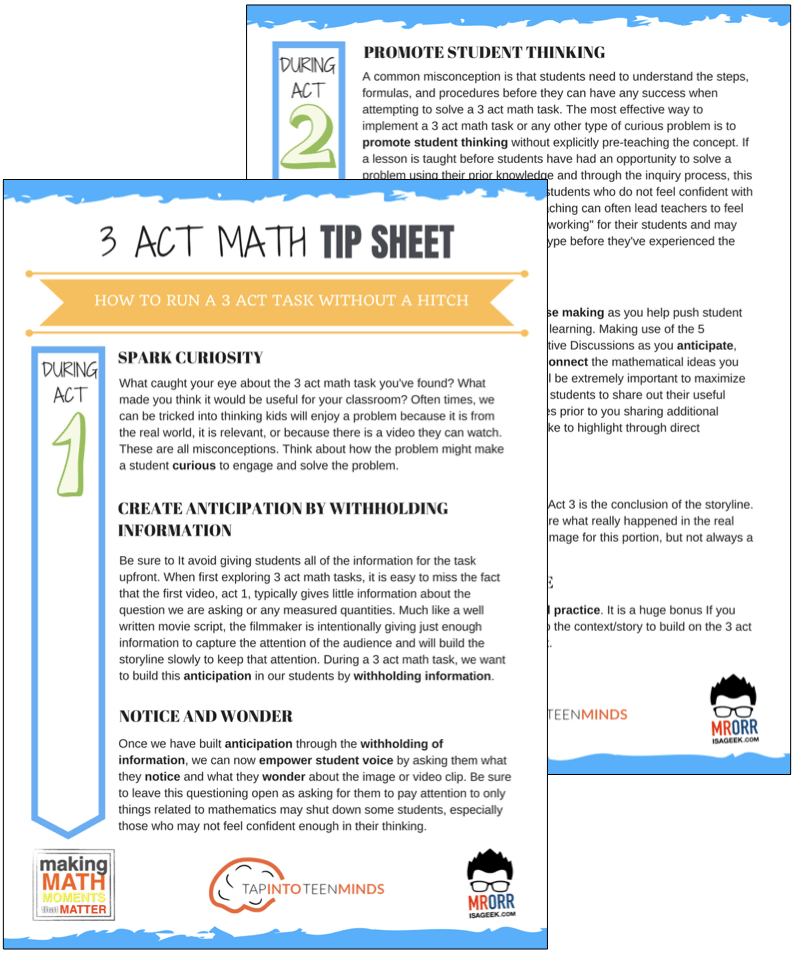
LESSONS TO MAKE MATH MOMENTS
Each lesson consists of:
Each Make Math Moments Problem Based Lesson consists of a Teacher Guide to lead you step-by-step through the planning process to ensure your lesson runs without a hitch!
Each Teacher Guide consists of:
- Intentionality of the lesson;
- A step-by-step walk through of each phase of the lesson;
- Visuals, animations, and videos unpacking big ideas, strategies, and models we intend to emerge during the lesson;
- Sample student approaches to assist in anticipating what your students might do;
- Resources and downloads including Keynote, Powerpoint, Media Files, and Teacher Guide printable PDF; and,
- Much more!
Each Make Math Moments Problem Based Lesson begins with a story, visual, video, or other method to Spark Curiosity through context.
Students will often Notice and Wonder before making an estimate to draw them in and invest in the problem.
After student voice has been heard and acknowledged, we will set students off on a Productive Struggle via a prompt related to the Spark context.
These prompts are given each lesson with the following conditions:
- No calculators are to be used; and,
- Students are to focus on how they can convince their math community that their solution is valid.
Students are left to engage in a productive struggle as the facilitator circulates to observe and engage in conversation as a means of assessing formatively.
The facilitator is instructed through the Teacher Guide on what specific strategies and models could be used to make connections and consolidate the learning from the lesson.
Often times, animations and walk through videos are provided in the Teacher Guide to assist with planning and delivering the consolidation.
A review image, video, or animation is provided as a conclusion to the task from the lesson.
While this might feel like a natural ending to the context students have been exploring, it is just the beginning as we look to leverage this context via extensions and additional lessons to dig deeper.
At the end of each lesson, consolidation prompts and/or extensions are crafted for students to purposefully practice and demonstrate their current understanding.
Facilitators are encouraged to collect these consolidation prompts as a means to engage in the assessment process and inform next moves for instruction.
In multi-day units of study, Math Talks are crafted to help build on the thinking from the previous day and build towards the next step in the developmental progression of the concept(s) we are exploring.
Each Math Talk is constructed as a string of related problems that build with intentionality to emerge specific big ideas, strategies, and mathematical models.
Make Math Moments Problem Based Lessons and Day 1 Teacher Guides are openly available for you to leverage and use with your students without becoming a Make Math Moments Academy Member.
Use our OPEN ACCESS multi-day problem based units!
Make Math Moments Problem Based Lessons and Day 1 Teacher Guides are openly available for you to leverage and use with your students without becoming a Make Math Moments Academy Member.
Partitive Division Resulting in a Fraction
Equivalence and Algebraic Substitution
Represent Categorical Data & Explore Mean
Downloadable resources including blackline masters, handouts, printable Tips Sheets, slide shows, and media files do require a Make Math Moments Academy Membership.
ONLINE WORKSHOP REGISTRATION
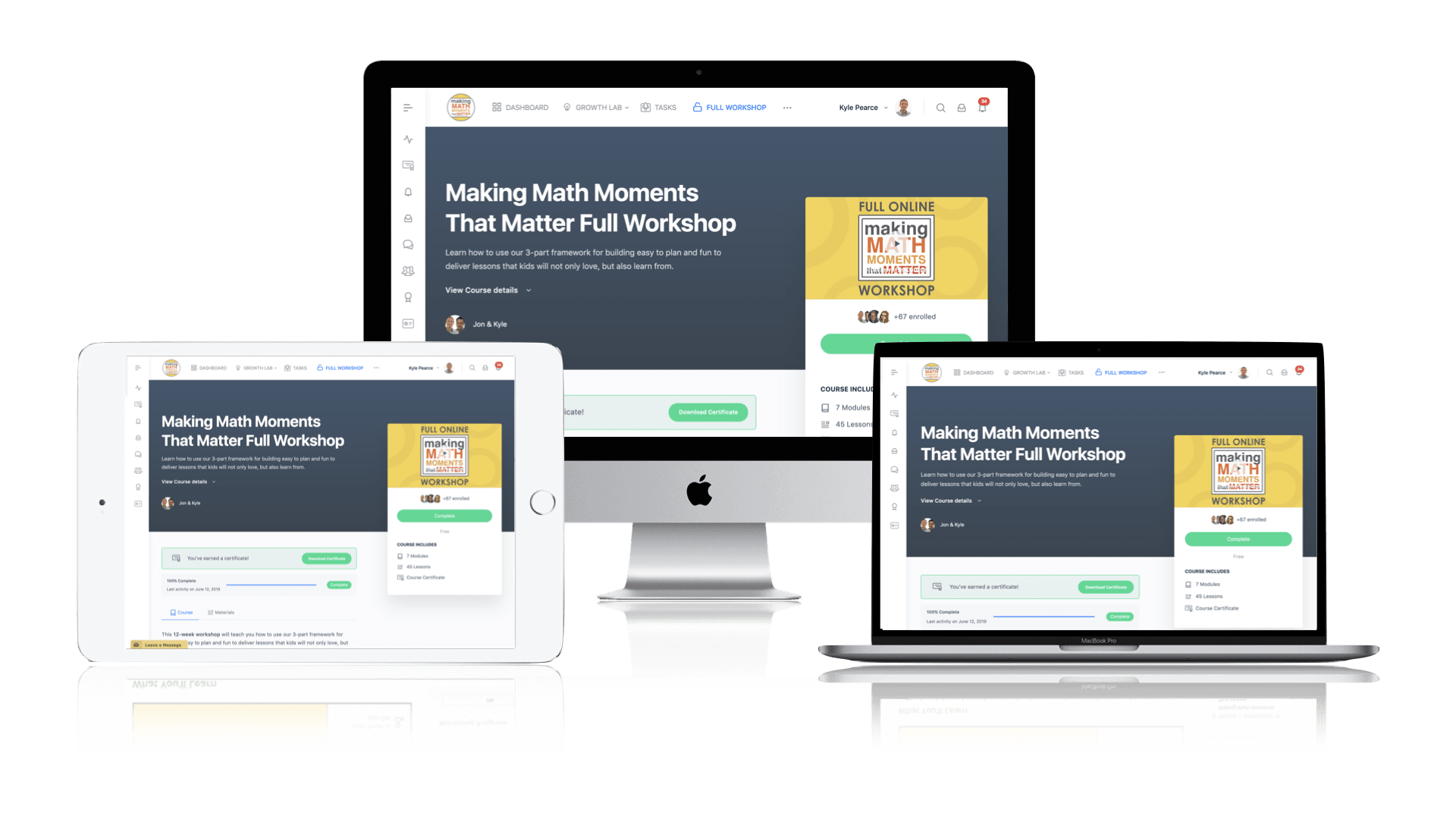
Pedagogically aligned for teachers of K through Grade 12 with content specific examples from Grades 3 through Grade 10.
In our self-paced, 12-week Online Workshop, you'll learn how to craft new and transform your current lessons to Spark Curiosity, Fuel Sense Making, and Ignite Your Teacher Moves to promote resilient problem solvers.
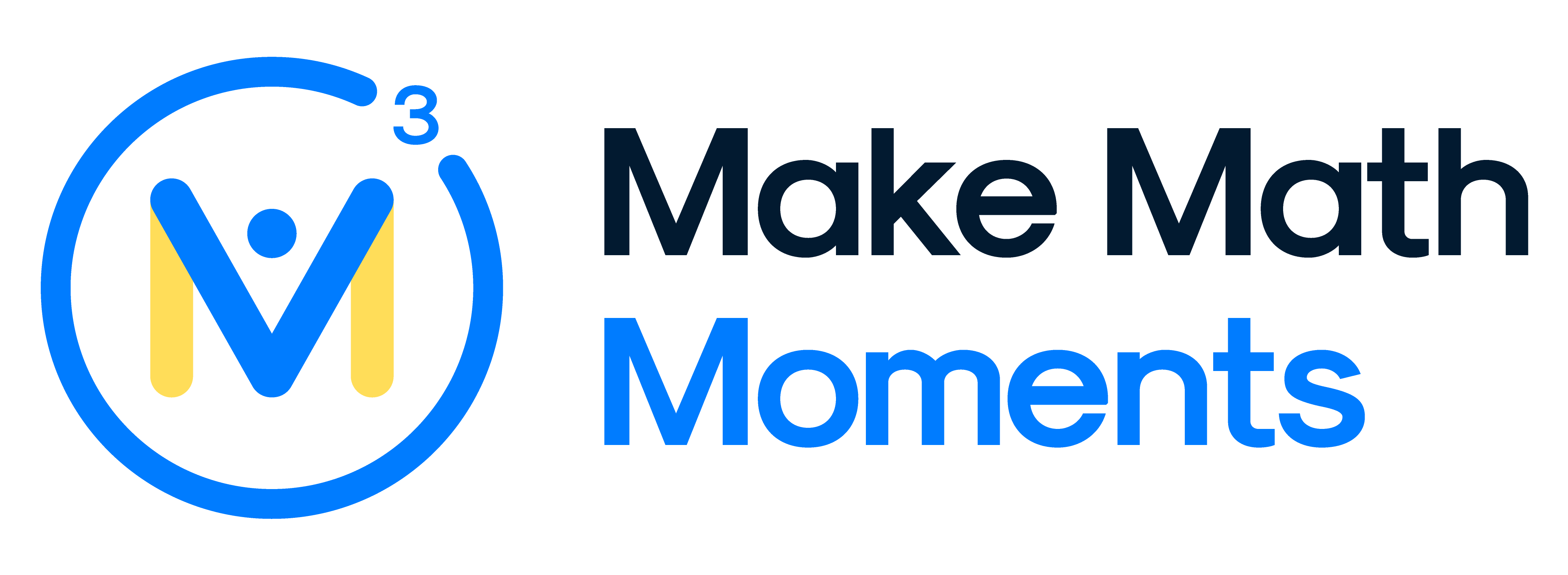



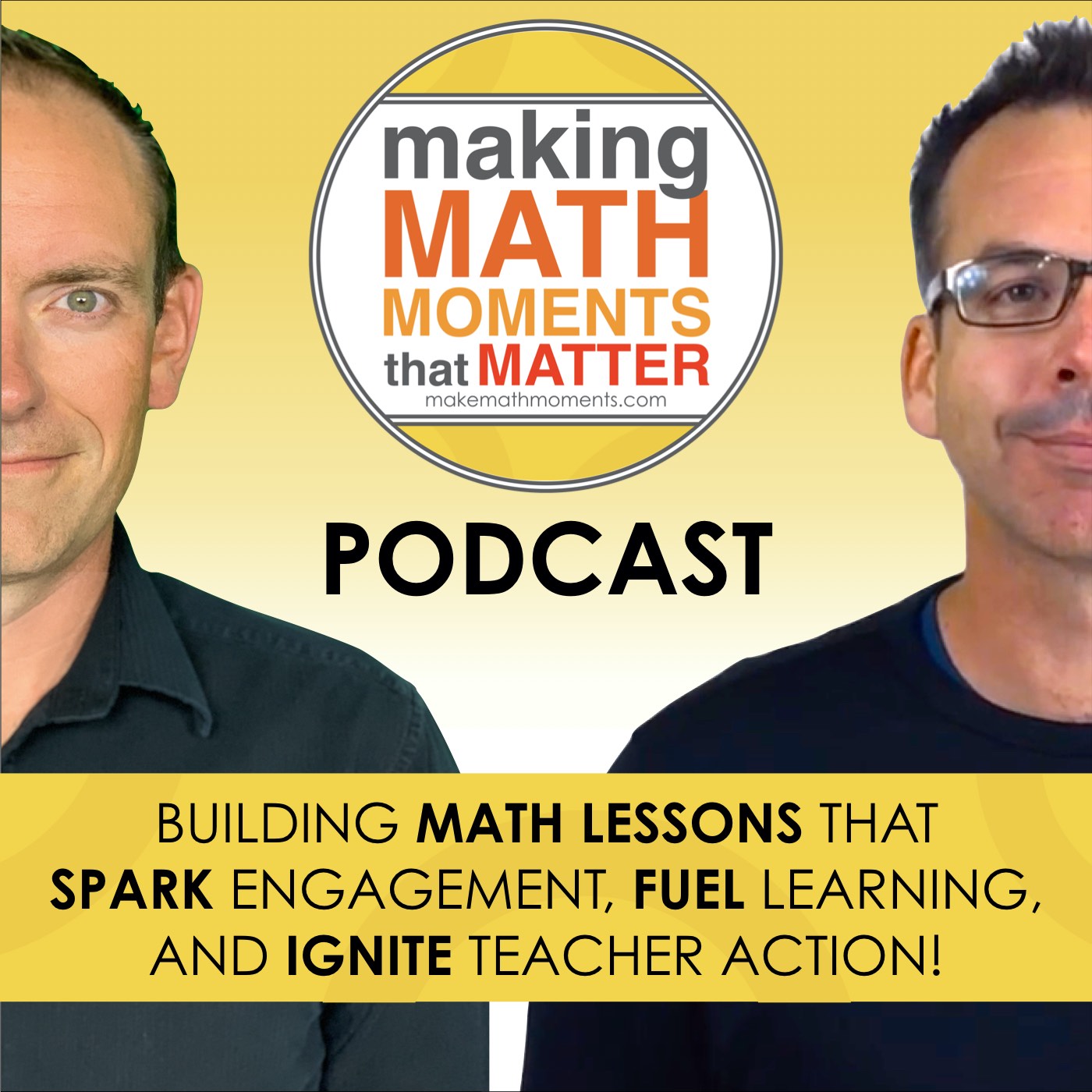
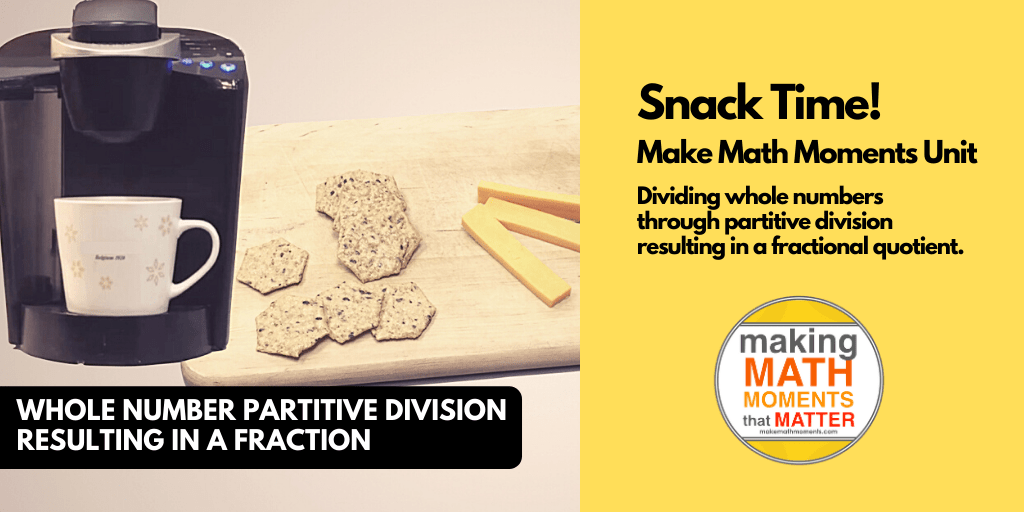
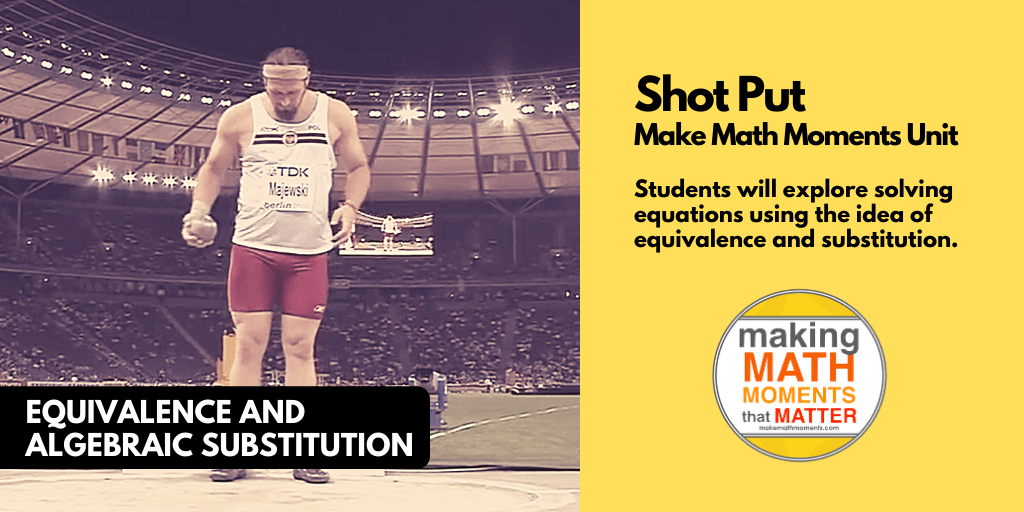
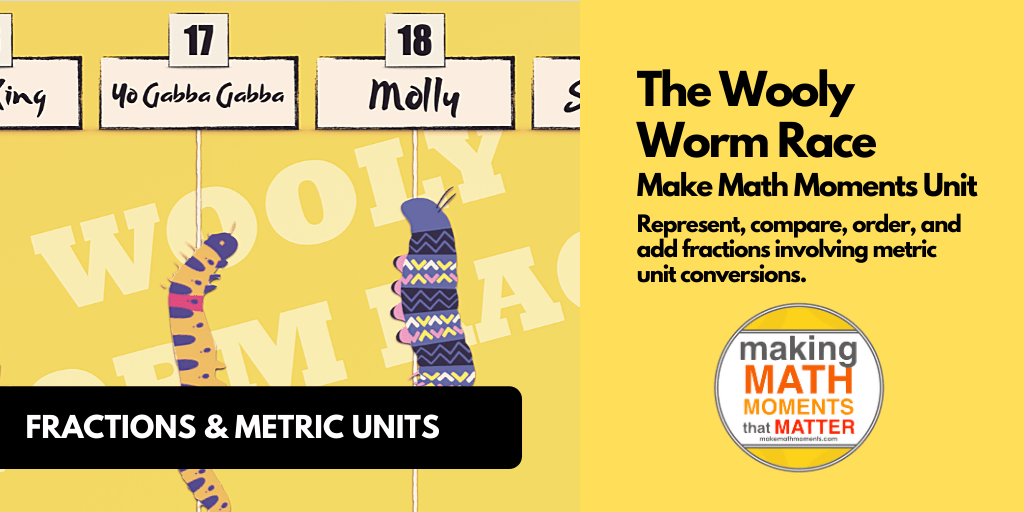
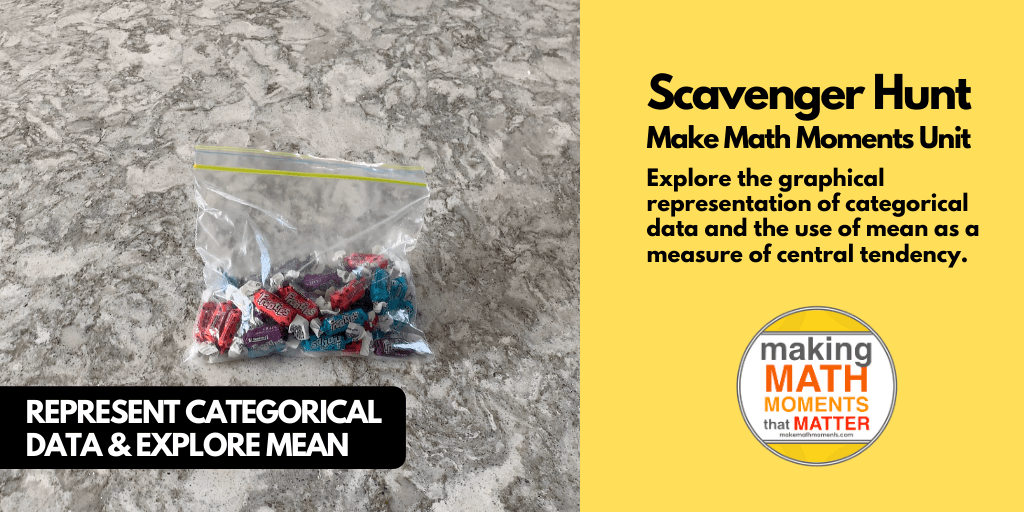

0 Comments